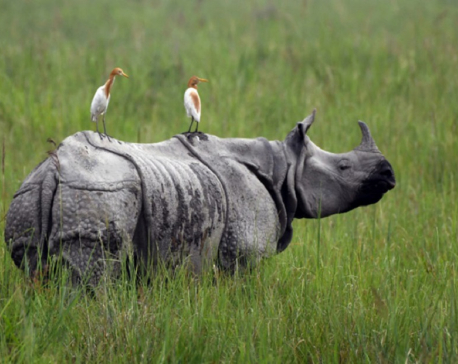
OR
Rhinos becoming target of electric traps
Published On: January 11, 2017 01:00 AM NPT By: Ramesh Kumar Paudel

Farmers set electric fences around their fields in order to protect crops from animals. The human-wildlife conflict in the buffer zone has been harshly taking lives of innocent rhinos.
CHITWAN, Jan 11: It has been more than two years since the endangered one-horned rhinos of Chitwan National Park (CNP) have not been poached by smugglers. Despite zero poaching of rhinos, their casualty rate has not yet come to an end.
Last year, electric fencing and use of chemical fertilizers in the fields adjoining the national park killed three rhinos, according to the national park officials.
The CNP has been claiming that since May 3, 2014, no rhinos have been killed by poachers. It celebrated two complete years of zero poaching of the endangered species. While they were planning to celebrate 1,000 days of zero poaching, the death of a rhino in Nawalparasi on January 2, has upset the officials.
Generally, the rare and endangered rhino is killed for its valuable horn, which fetches a good amount in illegal market. But the horn of the dead rhino found in Nawalparasi was not taken out, indicating that the rhino was not killed by smugglers. The rhino got trapped in an electric fence set by the farmers as it came in search for food and unfortunately lost its life.
Ram Chandra Kandel, chief conservation officer of Chitwan National Park, said, "Reports have proved that the rhino died due to electrocution." He also informed that this is so far second such case where a rhino died due to electrocution. Earlier on August 10, 2015 one rhino had died in Meghauli of Chitwan because of electric fencing.
The total number of the rare one-horned rhino in Nepal is 645. Chitwan National Park and nearby forests are the largest habitat of the rhinos in the country. The counting held in 2016 showed that Chitwan National Park alone has 605 one-horned rhinos.
Farmers set electric fences around their fields in order to protect crops from animals. The human-wildlife conflict in the buffer zone has been harshly taking lives of innocent rhinos.
"Electric traps set by farmers for the protection of their crops have been a great threat for rhinos and this is something for us to think about," Chief Conservation Officer Kandel said.
"Most of them are not aware that there is a provision of providing relief to the farmers as compensation if their crops get damaged by the wild animals," he added.
Kadel informed that according to the provision around Rs 10,000 is provided to the farmers whose crops have been damaged by the wild animals. People around the national park are well aware about this fact but people far from the area are still ignorant. "I don't think a rhino can eat crops worth more than Rs10, 000. These rare species and losing their lives for such a petty issue is really upsetting," said Kandel.
"As the number of rhinos dying because of these security systems is increasing day by day, we organized an awareness program where former chief conservation officer of Chitwan National Park Ram Prit Yadav delivered a speech about the importance of conserving rhinos," said Sur Bir Pokharel, chairperson of the Federation of Community Forest Users of Chitwan.
Madhukar Malla, chairperson of KUMROJ Buffer Zone Community Forest said that the relief amount provided by the government is very low and the process of taking the amount is also arduous because of which farmers keep adopting their own techniques to fend off wild animals".
According to Malla, there are lots of such cases in which wild animals have damaged crops of the farmers but they have not yet received relief.
As per the law, if someone kills a rhino s/he will be penalized Rs 50,000 to Rs 1 lakh and will also have to face a jail term of 5 to 15 years. This law is equally applicable for the farmers too. So it's a great problem from them.
"Farmers don't intentionally set these traps to kill wild animals," Malla added. So, he thinks that it is important for all people who are responsible for the conservation of wildlife to find some effective measures to solve this problem.
You May Like This

139 target for Rhinos in the eliminator
KATHMANDU, Dec 27: Indian batsman Sunny Patel’s late innings cameo has propelled Lalitpur Patriots to 138/5 in the 20 overs.... Read More...

30 rhinos die in nine months in Chitwan National Park
CHITWAN, April 18: Altogether 30 rhinos have died in the Chitwan National Park (CNP) and adjoining area in the first... Read More...

Preparation afoot to bring back rhinos swept away by flood
CHITWAN, Aug 16: Preparations are underway to bring back the endangered one-horn rhinos that were swept away or dislocated to... Read More...

Just In
- Indians vote in the first phase of the world’s largest election as Modi seeks a third term
- Kushal Dixit selected for London Marathon
- Nepal faces Hong Kong today for ACC Emerging Teams Asia Cup
- 286 new industries registered in Nepal in first nine months of current FY, attracting Rs 165 billion investment
- UML's National Convention Representatives Council meeting today
- Gandaki Province CM assigns ministerial portfolios to Hari Bahadur Chuman and Deepak Manange
- 352 climbers obtain permits to ascend Mount Everest this season
- 16 candidates shortlisted for CEO position at Nepal Tourism Board






_20220508065243.jpg)










Leave A Comment